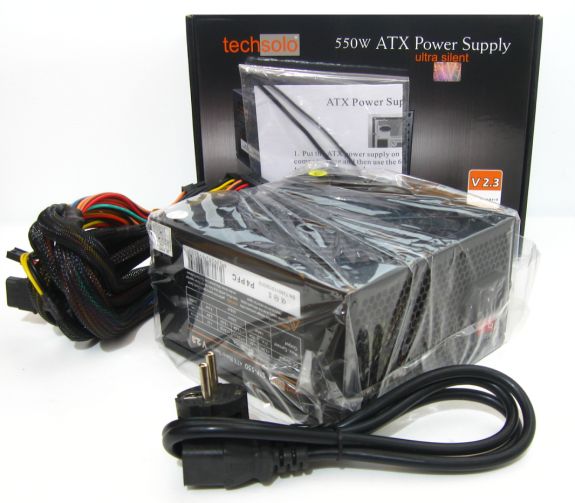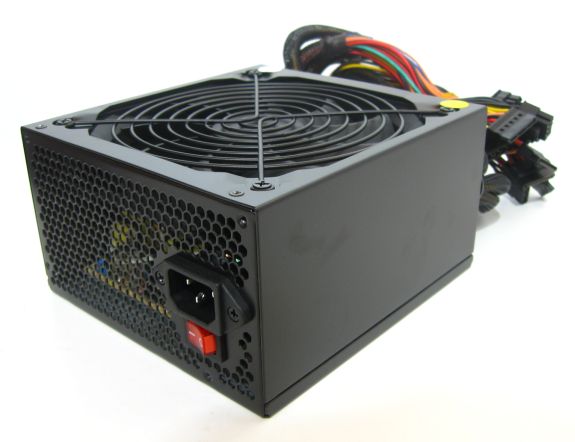550W Roundup: Three PSUs at Different Prices
by Martin Kaffei on October 28, 2010 4:00 PM ESTTechsolo Black Mamba STP-550
Techsolo keeps things simple with their packaging and extras. You get a standard power cable (for Europe), four screws, some cable ties, and a short user manual. The best-case hope for the Techsolo Black Mamba is that we'll get an "ultra silent" snake that can deliver the full rated power. I wouldn't bet on it, but more than one user has been tempted into going the cheap route on a PSU. At worst, the Black Mamba is a noisy blindworm that dies at 50% load, but most likely it will land somewhere in between those extremes.
The red (already mentioned and super-duper) power switch stands in contrast to the black case design. The fan grill and the cable sleeving are black too and the housing of the ATX 2.2-PSU is 14cm long. Considering the cost, the PSU actually looks decent—even cheap cable sleeving is a bump up over unsleeved cables, after all.
| Cables and Connectors | ||
| Fixed | Main | 24-pin 40cm |
| ATX12V/EPS12V | 4+4-pin 45cm | |
| PCIe | 6-pin 45cm | |
| Peripheral | 3x PATA 40-70cm + Floppy 15cm | |
| 3x SATA 40-70cm / 3x SATA 40-70cm | ||
The main cables are very short at less than 50cm, and there are only six SATA and three Molex power connectors along with a single PEG connector for graphic cards—the latter seems particularly skimpy. We don't want to be too quick to judge, but this is not a good configuration for a 550W PSU; it looks more like a 400W PSU. We'll get into more details on the next page.
Shenzhen Xin Wang Electronics Co., LTD. makes the fan, one of those nameless (despite the length of their name) Chinese companies. The 140mm fan needs fewer amps than the other fans in this roundup and it has nine fan blades. Will it be silent, and can it keep the PSU cool? We'll find out in a minute.













82 Comments
View All Comments
Spivonious - Thursday, October 28, 2010 - link
I really did laugh out loud when I came across "quadratic ventilation". Just say they're square holes.Spazweasel - Thursday, October 28, 2010 - link
It's interesting to see a conclusion that recommends reading a lot of reviews... the fact is, there have been very few power supply reviews compared to other PC components.Consider. With video cards, most manufacturers closely adhere to reference designs, differing only in cooler design (sometimes) and factory overclocks (sometimes). Yet upon the release of a new video chipset, we see reviews comparing offerings from several different manufacturers. Are we really expecting any real differences between, say, a 675Mhz 460 GTX from Palit compared to a 675Mhz 460 GTX from Asus, other than the noise and effectiveness of the fan? Yet we get that question examined and answered, in considerable detail. Video cards are sexy and fun to test.
However, with power supplies, it's inverted. It's clear that there are *substantial* differences between power supplies from different manufacturers, and that pricing does not track quality particularly well. Power supplies would benefit *more* from reviews comparing similarly-specced products from a wide variety of manufacturers. Yet we see very few power supply reviews. Anandtech has the best power supply reviews I've seen, examining real performance with repeatable, deeply technical benchmarks and tests, as opposed to "my computer turned on with it, the LEDs are pretty, Gold Editor Award" we see elsewhere. Anyone can install FRAPS and Speedfan then run timedemos and Furmark and call it a video card review. It takes skill and understanding and specialized equipment to test a power supply well. Anandtech has that skill; many other review sites do not. Your duty is clear!
I'd like to see more power supply reviews of this caliber, with the same intent to examine *all* major manufacturers that is given to video cards. As pointed out in the article, it can be just as important to spend wisely here as in other components, and I would therefore like to see proportionate coverage in power supplies.
JarredWalton - Thursday, October 28, 2010 - link
We had Christoph Katzer doing this sort of PSU review on a regular basis for a while, but then he had some other stuff come up that pulled him away. He ended up recommending Martin for his replacement and has helped (I think) Martin get set up for PSU testing. I expect we will have at least a few PSU reviews each month going forward, so we'll hopefully be able to cover more of the market as time goes by.dertechie - Thursday, October 28, 2010 - link
Most sites honestly just do not have the equipment or the skills to test the things (and I prefer they don't review them rather than test them poorly). Anand and Tom's have recently gotten back into it, but I know HardwareSecrets and HardOCP do a lot of PSU reviews with the proper gear, and I hear that JohnnyGuru does as well, but I haven't looked there myself. Most PSUs pass, but I've read enough reviews that there's no way I will buy an unreviewed unit for a build. Too many PSUs from otherwise reputable companies that failed, exploded, melted, took out the reviewer's wattmeter, or all of the above simultaneously.Spazweasel - Thursday, October 28, 2010 - link
Agreed. Some power supply vendors manufacture their own high-end power supplies but subcontract the mass-market stuff, often with no way to tell other than a trained eye which has seen that particular PCB layout before. Plus, any manufacturer can have a run of bad supplies, particularly if a component vendor lets them down (remember the capacitor issues a few years back which were traced back to a supplier that sold to many manufacturers ?).I have my own short list of power supplies that I use for my own and for friends' builds.
Antec EA380D for HTPC/entry level gaming rigs (it really is as quiet as the review says!)
OCZ 500MXSP for mainstream gaming rigs
Corsair 620HX for premium gaming rigs (my main gaming rig has this one, and has given flawless service... 8800GT SLI, E8500, everything OC by about 20%, rock-steady)
Anyone going higher-end than that doesn't need my advice.
Phaedrus2129 - Thursday, October 28, 2010 - link
I personally haven't seen a company manufacture its own high end, and outsource mass market things. Use different manufacturers, yes, but not manufacture some in-house and others OEMd. Antec did try that briefly, but found that running a factory was hard work and shut it down within a couple years.Maybe you're thinking of one of these brands?
PC Power & Cooling - Did not make own PSUs, despite best efforts to convince public otherwise. Used SeaSonic, Win-Tact, and FSP.
Thermaltake - High end is CWT, low-end is crappy HEC and FSP stuff
Antec - Have used CWT, Delta, SeaSonic, Enhance, FSP, and briefly their own factory, but never did what you described
Corsair - SeaSonic and CWT, and Flextronics for the AX1200
OCZ - Mainly FSP and Sirfa/Sirtec, though some older units were from Impervio and 3Y
Enermax - All PSUs made in-house, though they did outsource once or twice... Never made it a habit though.
SeaSonic - All made in-house
Those are the common ones I could see someone having misconceptions about... What brands were you thinking of that made their own high-end and outsourced the rest?
Also, FYI, the Corsair HX620 is discontinued.
Spazweasel - Friday, October 29, 2010 - link
The 620HX may be discontinued but it's still readily available.http://www.newegg.com/Product/Product.aspx?Item=N8...
tomoyo - Friday, October 29, 2010 - link
Actually the HX620 still exists, you can buy it on newegg right now. Which is kinda dumb because it's basically been replaced by the HX650 (updated version of HX620).Spazweasel - Friday, October 29, 2010 - link
See, this is the kind of thing I'd like to know. Is the HX650 based upon a new design? Does it have anything to do with the 620, did Corsair just up-rate it, or is my experience with the HX620 irrelevant to the HX650? We've seen that we can't just make the blanket assumption that good experience with one P/S model from a given manufacturer is a good indicator of other models.My own knowledge of the HX620:
1. It has all the juice I need for my system. Under load, the wattmeter on my UPS says my system pulls about 240-250 watts, so it's lightly stressed, but that still would have blown up under the tender ministrations of the Techsolo.
2. I've never had any problems with this power supply. It's given perfect service.
3. Corsair has treated me right. I managed to misplace the modular cables which I didn't use as part of the original build. When I needed those cables due to additional hard drives and adding the second 8800GT, I called them up and asked how I could order more cables. They sent me a full set of modular cables without charge (not even postage), and the cables arrived in 2 days.
I'm inclined to believe that the HX650 would be as good, but.... review! I wanna review! :)
Phaedrus2129 - Friday, October 29, 2010 - link
Both are made by SeaSonic. The HX620 is a SeaSonic S12, which was SeaSonic's main high-end platform until it became mid-range.The HX650 is S12E, which is basically just an updated version with higher efficiency. Same performance otherwise. Still a decent unit. Usually a bit pricey for its performance though.